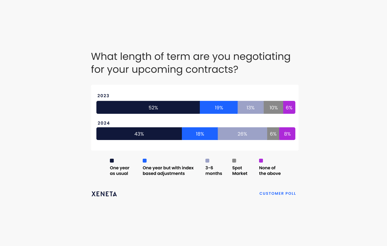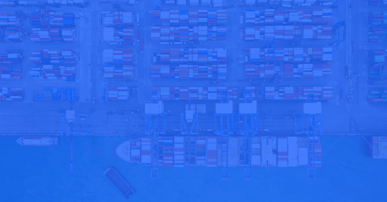As a supply chain professional who is involved in air and ocean freight rate negotiations, do you feel like you're not getting the most out of your dollars?
If so, you're not alone. There are many such questions and concerns that cloud the judgment of your peers as well. But most of all, it’s the fear of failing in freight buying that keeps them up at night.
With market conditions changing continuously, maybe it is time for you to introspect if you need to change the game. Sticking to the same old procurement process might be costing you more than you realize.
After discussing with top transportation procurement pros, we've nailed down the top four reasons why your freight buying process might be holding you back. No need to worry! We've got some clever tips up our sleeves to help you gain a competitive edge. Prepare yourself to elevate your performance to new heights.
1. Not Knowing When Is the Best Time to Negotiate Air and Ocean Freight Rates
Knowing when the best time to negotiate freight rates depends on who you are as an entity and what is most suitable for you, your business, and your supply chain. No general time frame suits everyone.
No matter who you are or what business you're in, if you're negotiating air or ocean freight rates, freight benchmarking data can give you a major edge. By analyzing historical, present, and future data on contract rates, global trade trends, and capacity management data, you can pinpoint the perfect time to negotiate and score the best possible rates.
Consumer demand can change at the flip of a coin. You need a supply chain that can thrive, whether it lands on heads or tails.
So what can you do to time your negotiations perfectly to make the most of your dollars?
Use data to look behind the curtain and get ahead of the supply chain curve. Identify current and past cost-savings opportunities with benchmarking and historical analytics and let the numbers show what works. Ensure your future strategies align with the market and take that intelligence to the bank.
2. Not Choosing the Right Carrier
Whether you are a BCO (Beneficial Cargo Owner) with big volumes of specific cargo on multiple trade lanes or an OTI (Freight Forwarder or NVOCC) with big volumes of FAK (Freight All Kinds) cargo on multiple trade lanes, choosing the right carrier is of paramount importance to the success of your business.
Understanding when to choose a carrier based on trade lane or global volume is the next step in making the right decision.
While there are many global carriers out there, it's important to remember that not all of them will be the perfect match for your supply chain needs. Depending on your unique business requirements and trade lanes, there may be better options out there. Don't settle for a one-size-fits-all solution - find the carrier that's tailored to you.
Conversely, when you consolidate your global volumes and opt for a global carrier, you gain the flexibility to make adjustments to your total global volume versus local trades. This kind of flexibility may not be available with a local or regional carrier. By choosing a global carrier, you can ensure that your shipping needs are met no matter where your business takes you.
Many supply chain professionals prioritize high service levels, competitive pricing, and timely shipments. However, they often fall short of achieving their full potential by solely relying on strong supplier relationships and periodic performance assessments.
But here's the million-dollar question - What is the real cost of your loyalty?
Data can provide you with precise answers. It's time to find a more efficient way to measure your supplier's success. If you're not getting the best value for your investment, you have a straightforward decision to make - choose the right carrier that aligns with your goals.
3. Lost Potential: Neglecting Freight Rate Benchmarking with Competitors
If you are not benchmarking your air freight or shipping container rates with your peers and competition, how will you know if you have received a competitive rate from your supplier?
To make sane freight procurement decisions, you need to know how your rates compare to your peers and the market.
In today's market, carriers are all about cutting costs and boosting their profits through mergers, alliances, and more. It's tough to keep track of container rates amidst all the socioeconomic factors at play. But if you're a BCO, NVOCC, or Freight Forwarder, don't miss out on the benefits of freight benchmarking against your peers. It's the only way to ensure you're getting the best possible rate and supplier for your needs, so you can make informed procurement decisions. And with all the data you need in one place, you won't waste time or risk guesswork. In this dynamic industry, you need to stay on top of your logistics game with real-time insights into market movements and freight rates.
4. Not Choosing The Right Contract Type Corresponding To Your Business Needs
Freight rate negotiation is an art, and if not done correctly, you could be leaving money on the table.
For example, if you consider a 12-month fixed ocean freight rate, is it possible that you may be leaving money on the table? The answer is - yes and no.
Let's assume an example of two BCOs in a competitive environment to understand this better. BCO #1 ties in their rates for 12 months at the beginning of the year. BCO #2 negotiates a 12-month contract with quarterly reviews/adjustments based on market movements.
Now if during the 12 months, the market moves significantly upward. The first BCO' wins in this case. However, if the market moves up and down - let's say down – BCO #2 "wins" as rates are adjusted downwards, and they have the flexibility in their contact to do reviews and adjust.
Is negotiating rates on a longer-term basis the best option for shippers with big volumes? The answer is not that simple, especially with the volatility of container rates, which has shown that volume does not always equal savings. To make informed decisions, shippers should use freight benchmarking to analyze trade lane performance and anticipate market trends. With this actionable data, shippers can determine whether fixed rates for 12 months, 6 months, quarterly, short-term, or a combination is the best approach.
Stop playing it safe and sticking with what you know.
Business objectives must be realistic and in line with the market, which means global market transparency is a must.
Market transparency is a must-have
Are you looking for visibility into the volatile container shipping market? Find out how simple it is to get the insights and intelligence you need to make sure you, your team and your business quickly adapt to changing market conditions.
Know instantly how your air and ocean freight rates compare against the market, justify your transportation costs, prepare for your tender period and report on your success with one powerful easy-to-use platform. Get a demo now!
%201.png)


-1.jpg)




